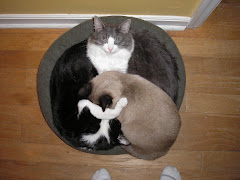Chris says,
i want bodies to be more visible in academia. physical bodies *should be* more visible in academia. not (half)naked bodies, but bodies made present. bodies looked *at* as opposed to through. as doing and not simply done to. as creating and not just containing i.e. not "embodying" knowledge, but itself knowing.
But, no, I'm not offering any close-ups of my biceps or anything below. In fact, my "body composing process" takes a different direction from Chris's. But that's part of the point, no? How do bodies know? Surely in more than one way. And maybe in ways that aren't always visible by looking.
For example, last week I did a 2 1/2 hour yoga workshop with Doug Swenson, author of, yes,
Power Yoga for Dummies and
Mastering the Secrets of Yoga Flow. Power Yoga (ie, hot and sweaty yoga) is not my usual choice of yoga, though I have tried it out. After all, according to
a quiz at yogajournal.com, I'm a "Balanced Yogi," one who isn't dogmatic or snobbish about yoga. I'm interested in everything yogic, even if I do have predilections in favor of certain styles over others. (
Iyengar is my foundation, if you want to know, but some teachers in that style are a little too inflexible for my taste. Pun intended.)
At the workshop, Doug demonstrated some pretty amazing postures that he moved in and out of with the most beautiful grace and fluidity. Here he is in an arm balance, for example (though not from the workshop, which was held indoors):

I can look at the photo and I can see what his body knows. I could watch him move at the workshop and see what his body knows, what it can do.
Usually, I take yoga classes with S., mostly her "Deep Stretch" class on Saturday mornings. She calls it "Yin Style" yoga. When I'm doing deep stretch, I can feel changes happening deep inside my body. What does it look like from outside? Probably not much. Certainly not like an impressive arm balance on a cliff. But my body is learning. My body is doing. My body is revising itself, learning to be in new ways.
So I was reading about "yin yoga" online, and found the website of yin guru Paul Grilley. Yin yoga focuses on holding poses for long periods of time (as in 5-10 minutes, not hours or anything) in order to affect the connective tissues. Because of his interest in bodily connections (hmmm...I often talk to grad students about working on the "connective tissue" in their writing), he also gives workshops on joints. He also brings attention to bones, how the shape of bones affects how muscles can move. Here's a link to a slide show on bones. Just look at the differences in those clavicals! Look at the different angles in the two femurs. Grilley says:
The bend at the neck of the femur of these two specimens vary by 40 degrees. This could mean 40 degrees wider splits.
Forty degrees difference! And here I've been thinking that when a yoga teacher says "every body is different" she meant that every body has a different level of fitness. No. In fact, every body is different. Differently composed. And so differently able.
But those things are hard to see. They're under the skin. Under the muscle. Hidden away.
How do we make visible the composing processes of bodies like those? Exceptional bodies, bodies with spines that wind like a river, hip sockets oriented inward rather than outward? How to make visible the subtle changes that happen when a body relaxes, as in restorative yoga?

The body is supported. It relaxes. The mind relaxes. Muscles decontract. It's hard to see. But it's there, all the same.



